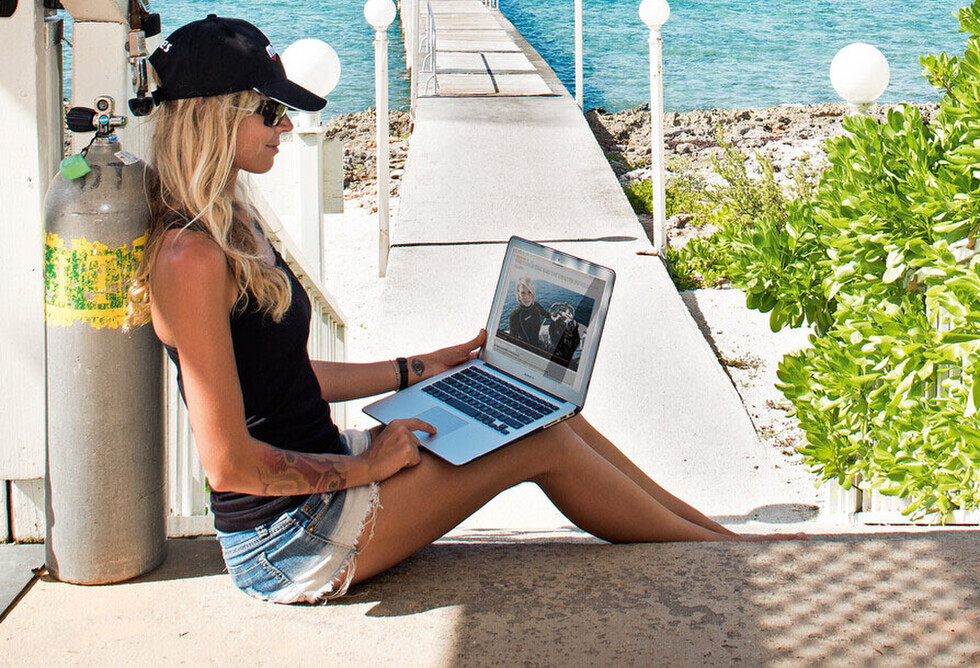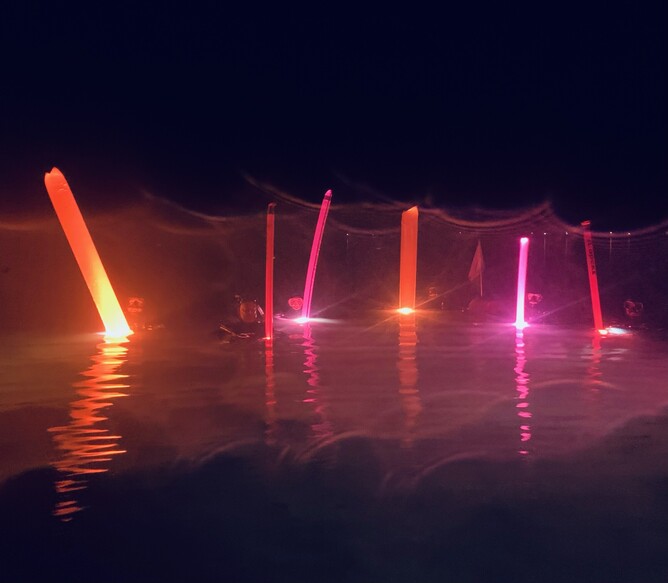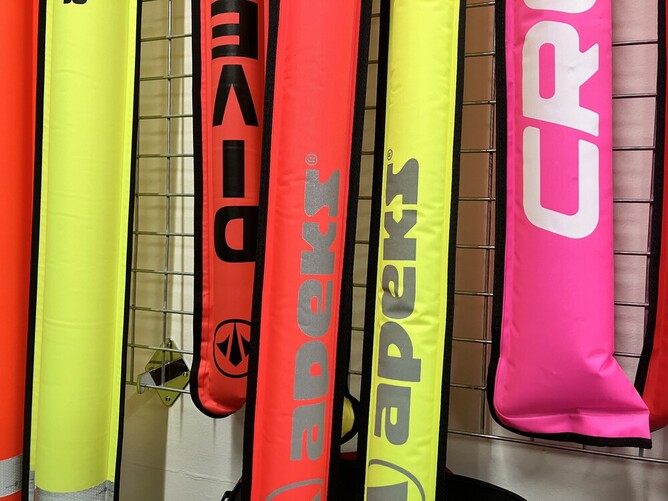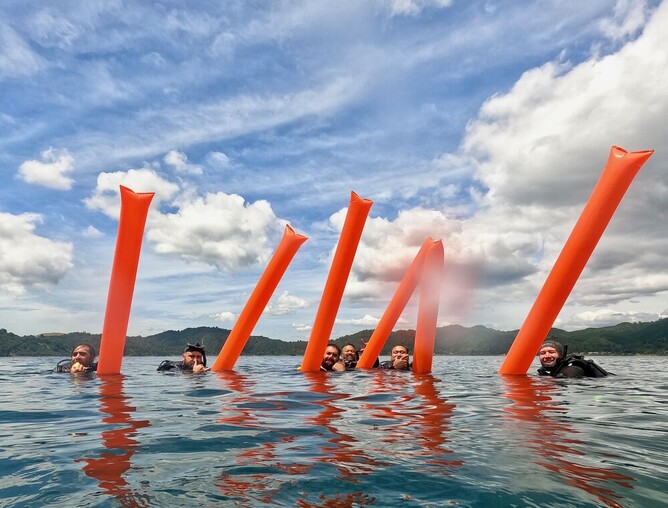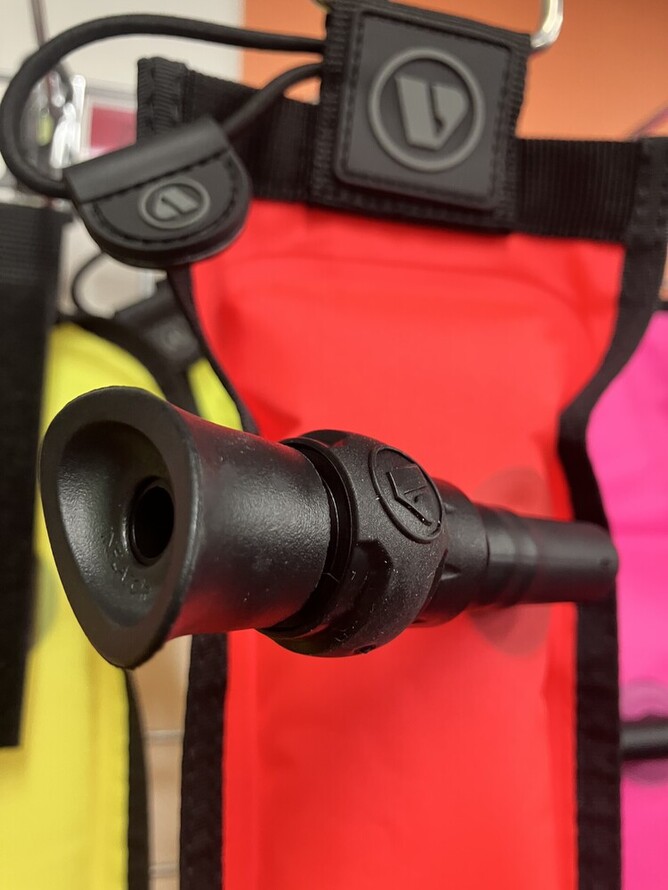Why every diver should carry one
If you dive from boats, shore entries where boats are present, in currents, or anywhere visibility or boat traffic could be a concern, a Delayed Surface Marker Buoy (DSMB) is one of those small, inexpensive pieces of kit that can make an enormous difference when things don’t go exactly to plan.
One of our personal favourites is the Apeks’s 1.4-metre DSMB (also known as the Apeks SMB). It is a compact, well-thought-out marker buoy built for the realities of recreational and technical diving. In this post we’ll walk through the DSMB’s key features, how it’s put together, practical deployment tips, and the safety reasons you should carry — and practice with — a DSMB on (almost) every dive. At the end of this blog we will disclose why the Apeks SMB is our favourite out of the range of SMB's we hold in stock, read on!
Quick product snapshot:
Product: Apeks DSMB / Surface Marker Buoy — 1.4 m (4.6 ft)
Colours: Orange or Yellow with black trim (high-visibility options).
Key features: fully closed oral inflation system (single-breath inflation), SOLAS reflective tape panels on both sides, over-pressure relief valve, fully taped and heat-sealed edges for durability, bungee closure with enlarged pull tab, brass eyelets for forming a floating loop / emergency float. 
Design & build — what makes the Apeks DSMB stand out:
Single-breath, closed-system oral inflation
One of the headline features Apeks promotes is a “fully closed system oral inflator” that allows the DSMB to be fully inflated with a single breath. That’s not marketing fluff - in real world deployments it matters. When you’re at depth, or in a chop or current, the ability to inflate and launch (bagging off) the DSMB quickly and with minimal fuss reduces the time you spend dealing with kit and frees you to concentrate on your ascent and line control. Apeks’s valve design also prevents the gas you add at depth from escaping as the DSMB travels to the surface. 
Visibility: SOLAS reflective panels and bright colours:
The tube is brightly coloured (orange or yellow) and fitted with high-quality SOLAS-grade reflective tape on both sides so it reads well to surface lookouts, boat crews and searchers even in low light or choppy seas. Visibility is the DSMB’s primary job — making you noticeable from a distance — and Apeks’s dual-facing reflective panels increase the chances you’ll be spotted the first time someone looks. 
Robust construction and small pack size
Apeks’s SMB is manufactured with taped and heat-sealed edges to improve durability and reduce seam failure. At 1.4 m long and typically around 15 cm (6 in) wide when deflated and stowed, it packs down small in your BC pocket or clipped off on a harness but deploys to a size that’s useful for marking you in most recreational and many technical dive scenarios. The heat-sealed construction and simple bungee closure with a large rubber tab is excellent for dexterity for gloved use. 
Over-pressure relief valve (OPV) and practical fittings
A useful practical feature for cold or gloved hands is an over-pressure relief valve with a pull toggle — it prevents overinflation damage as the air expands on the ascent and makes it easier to operate with thick gloves. Brass eyelets at the ends allow you to secure the DSMB into a floating loop for use as a small emergency float or to clip it in while stowed. These small details make the DSMB more functional in real diving conditions. 
Why a DSMB is essential: the safety case
A DSMB is not just a piece of optional kit for “serious” divers - it addresses a set of real, repeatable hazards most divers face.
1) Signalling and locating divers (primary function)
The DSMB’s main job is to tell the surface where you are. Bubbles and heads are very hard to spot from a boat or from a distance, especially in choppy seas or over rough water. Deploying a DSMB before you surface - the classic “delayed” deployment - allows boat crews and other surface personnel to identify and track your position before you break the surface. That reduces the risk of missing you and dramatically shortens the time it takes to pick you up. SCUBA training agencies and many dive safety authorities emphasise that launching a DSMB prior to surfacing is an important safety technique to alert others to your location. 
2) Drift diving and current control
In currents, divers often separate from the entry or pickup point. A DSMB marks your drift so the boat can match the movement of the group and effect a safe recovery. It also allows you to control your ascent rate and perform your safety stop on the DSMB line when there’s no fixed reference (reef or anchor line) available. Dive training agencies commonly teach that the DSMB can be used as a vertical reference for safety stops in current conditions. 
3) Reducing boat strike risk
A bright, reflective tube is far easier for a boat operator to see than a diver’s head or bubbles. This is a concrete life-saver when there’s only a small window of visibility or when traffic is heavy. Using the DSMB correctly communicates to boat crews that people are in the water and gives them a clear target to avoid.
4) Emergency signalling and peace of mind
If something goes wrong — separated buddy, equipment failure or being swept away at sea - deploying the DSMB tells the surface you need help. That fast visual communication can be pivotal in getting assistance quickly and avoiding escalation into a more serious incident. As many experienced divers note, the DSMB is small, lightweight and cheap compared with the cost and consequence of delayed recovery. 
Open water diver training including SMB deployment
How to use a DSMB safely — practical tips
Owning a DSMB is only part of the equation. Surgeons don’t practice on patients, and divers shouldn’t use a DSMB first time in an emergency. Here are practical steps and tips to get the most safety out of it:
Firstly choose the (Do it) right training centre and instructor, not everyone teaches the use of SMB at entry, learn to dive level - (All open water diver students at Aotearoa Dive are coached and practice safe use of a surface marker buoy and all students training at a higher level are required to be proficient in DSMB deployment on every training dive).
Choose the right deployment method
A DSMB is typically deployed either from depth (using a reel or spool) or as you reach the surface (quickly inflated). If you’re doing a delayed deployment from depth, attach the DSMB to a reel or finger spool and pay the line out slowly as the DSMB ascends. Practice controlled deployment to avoid line twists, snagging or uncontrolled buoyant ascent.
Practice one-handed inflation, one-handed release
The Apeks one-breath closed oral inflator is designed for simple single-breath inflation. Practice in a pool so you can do this while neutral and trimmed out correctly and with one hand, simulating conditions where you might be using a compass or holding on to reef. Also practice quick-release of the reel or line so if the DSMB fouls you can cut the line cleanly with your cutting tool.
Use the over-pressure relief valve correctly
When inflating at depth, you typically add a modest amount of air — the DSMB will expand as it rises. The OPV prevents overpressure damage; get familiar with how to vent and how much to inflate initially. Apeks’s pulled toggle design helps glove users operate the valve. 
Avoid entanglement risks
Training guidance (and many safety investigations) highlight the need to manage entanglement risk. Many divers now prefer to hold the DSMB rather than clip it to their BCD while ascending (please don't clip your DSMB to any part of your total dive system), and to attach the reel in a way that allows quick release (by hand) if needed. Practice and good kit routing prevent the DSMB line from wrapping around cylinders, regulators or other divers. All other divers in the team should always be watchful and mindful during any DSMB deployment - and at the ready with line cutters should the need arise.
Pre-dive kit check & stowage
Put the DSMB in an accessible pocket or in a position on your harness where you can get it out quickly with one gloved hand. The Apeks design’s bungee closure and enlarged rubber pull tab are specifically intended to make one-handed stow and retrieval easier. Inspect the valve, seams and eyelets for wear at the start of each dive. 
Maintenance and care
A DSMB is low-maintenance, but a little care extends life and reliability. Treat it like any other other piece of dive equipment:
Rinse thoroughly in fresh water after saltwater dives, flushing the oral valve and OPV.
Inflate occasionally and inspect the seams and taping for damage.
Avoid storing with sharp objects; roll it loosely rather than creasing it sharply.
Replace if you notice seam separation, punctures or if the valve leaks.
Keep it out of the sun as best as you can, they can colour fade over time and lose their vibrancy.
We carry a full range of sizes, colours and budgets.
A robust SMB like the Apeks is built to last, but it’s still a safety device - treat it like one.
Choosing the right size: why 1.4 m is a good compromise
DSMBS come in many lengths; Apeks’ 1.4 m (about 4.6 ft) model hits a good compromise for recreational and many technical uses. It’s long enough to be seen in moderate seas and compact enough to stow easily in a BC pocket. For heavy seas, technical profiles or groups that need a larger surface signature some divers opt for longer versions (2 m or more), but the 1.4 m size remains the most popular all-round choice for dive guides, instructors and regular divers. The Apeks model’s reflective panels and the single-breath oral inflator help it perform beyond what size alone might suggest. 
Real-world scenarios where a DSMB saves the day
Drift dive pickup: you deploy the DSMB at depth; the boat tracks the inflated marker buoy rather than the divers’ bubbles and recovers everyone quickly.
Low visibility / night operations: reflective panels and bright colour help surface lookouts locate you. (For night dives a torch will illuminate any SMB like a beacon visible over great distances).
Separation from the group: if you surface away from the boat, the DSMB reduces search time.
Safety stops in current: you anchor your safety stop to the DSMB line to avoid being swept off depth control.
These are not hypothetical: dive magazines, safety bodies and accident investigations regularly highlight DSMB marking as a key factor in safe recoveries. 
Final thoughts — small, simple, essential
A DSMB is a modest investment that pays off in safety and confidence. Apeks’s 1.4 m DSMB is a thoughtfully designed, rugged marker with features aimed at real-world usability: single-breath closed inflation, SOLAS reflective tape on both faces, an OPV for safe ascents, heat-sealed seams and gloved-friendly stow/release hardware. More importantly than any spec sheet: learn to deploy it confidently in calm, controlled conditions before you rely on it in a stressful situation. Practice one-handed inflation, working with a reel or spool, and quick release in case of entanglement.
Whether you’re a weekend reef diver, a liveaboard traveller, or someone prepping for adventurous drift dives, carrying and practising with a DSMB such as the Apeks 1.4 m is a straightforward, practical way to make your diving safer — and to make you much easier for the surface team to find when it really matters. 
⸻So why do we love the APEKS SMB so much? It's really a simple solution for us diving in colder Aotearoa temperate water conditions. The majority of SMB's on the market have a standard BC QD valve that enables the diver to use a low pressure hose for inflation (similar to your BC inflator hose), however try to orally inflate one of these in the middle of winter when your lips are cold, and you soon find out it is near impossible, you will struggle to form a seal with your lips and therefor probably fail at inflation.
The APEKS comes with a unique inflator system designed specifically to be easy to orally inflate even when you can't feel your face! It's as easy as blowing into a trumpet mouthpiece, and yes it actually works, even in the depths of winter!
A winning design feature!
At Aotearoa Dive we always carry a full range of SMB's, DSMB's and reels as safety is our primary focus. We have a range of sizes, colours, and different manufacturers models. Our staff are more than happy to discuss your personal requirements and we certainly carry something to suit all budgets.
For more information on the APEKS SMB - CLICK HERE
For more information about our range of SMB's - CLICK HERE
For more information about our range of associated reels/finger spools - CLICK HERE
If you would like any further advice, please do contact us by CLICKING HERE
